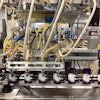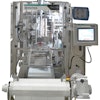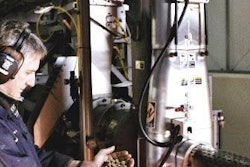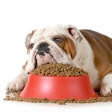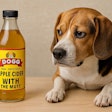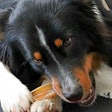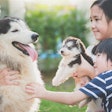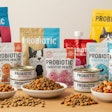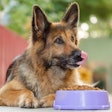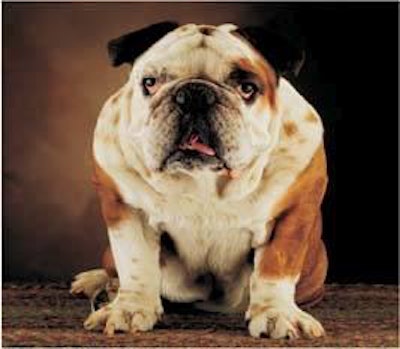
Pet obesity is a widespread and dangerous disease. It is hazardous in several insidious ways. Common conditions such as heart disease, arthritis and diabetes can all be caused or worsened by obesity. The petfood industry has an opportunity to do much more to prevent and manage dog and cat obesity.
Lack of awareness
The perception of most veterinarians is that obesity continues to be on the rise. One reason is a lack of awareness on the part of the pet owner. The American Animal Hospital Association 2000 "Pet Owner Survey" reported that 17% of pet owners rated their pet as overweight. Veterinarians estimate that 44% of their patients are overweight. This discrepancy illustrates pet owners' lack of awareness as to what an appropriate body condition should be for their pet. Without awareness, pet owners don't take the necessary steps to correct the problem.
Industry's role
Besides lack of awareness, there are other forces at work, within the petfood industry, that may be playing a role in the pet obesity epidemic. They include:
- Dry petfoods are gaining a greater share of the total petfood market.
- The popularity of higher-fat petfoods continues to rise.
- Pet owners are giving their pets more treats and less exercise. Perhaps the treats help assuage the guilt pet owners feel for not giving their pets more exercise.
These petfood industry trends give petfood makers an opportunity to help pets and pet owners. By taking the following steps, petfood companies could help prevent pet obesity:
- Address pet owners' lack of awareness that their pet has a problem.
- Recommend adding water to dry food and/or decrease the energy density of dry food (increase the air content).
- Provide more calorie information on labels and supporting websites.
- Give specific exercise recommendations, including recommendations for decreasing regular meal amounts.
- Supply clear feeding guidelines for treats, including recommendations for decreasing regular meal amounts.
- Encourage pet owners to adjust food intake so that their pet maintains an ideal body condition. Stress that recommended feeding amounts are only starting points and will likely need to be changed.
Obesity can have numerous adverse effects on pet health. In addition, it has been proven to decrease the lifespan of pets. A major goal of preventative medicine should be preventing and treating pet obesity.
From water to carbohydrate
Sales trends that may be impacting the incidence of pet obesity are evident. Data from "The Petfood Report" ( Petfood Industry , November 2000 and November 2003) show:
- Dry dog food sales increased by 16% from 1999 to 2003, while wet dog food sales increased by only 7.3%. The estimated figures for 2003 showed that wet dog food sales decreased by 0.4% compared to the previous year.
- Dry cat food sales increased by 17.3 % from 1999 to 2003, while wet cat food sales decreased by 6%.
When pet owners go from feeding wet food to dry food, they are shifting their pets' diets from a predominantly water-containing diet to a more carbohydrate-containing one. This shift from water to carbohydrate creates the potential for inadvertently increasing energy intake.
To illustrate this potential, a survey of the top selling cat and dog foods shows that the energy density of wet food is generally lower than that of dry food. For dog foods, wet food provided 228 kcal/cup, while dry food provided 391 kcal/cup. For cat foods, wet food has 252 kcal/cup, while dry food has 377 kcal/cup.
Label feeding guidelines partially take into account this increase in energy density. However, data show that the feeding recommendations still need work. Dry dog food recommendations average 87 kcal/kg body weight, while wet dog food recommendations average 81 kcal/kg body weight. This 7.4% difference is seemingly innocuous, but, over the course of one year, it would lead to a 27% increase in body weight. Dry cat food recommendations average 76 kcal/kg body weight, while wet cat food recommendations average 64 kcal/kg body weight. This 19% discrepancy would result in a 48% increase in body weight over the course of a year.
From carbohydrate to fat
The 2003 "Petfood Report" also indicated that there is "a shift in consumer preferences toward higher priced goods." Although there are no AAFCO guidelines regarding the qualities a "premium" petfood must possess, higher priced petfoods generally are defined by their higher fat content. This is mainly due to fat's ability to increase palatability, decrease fecal bulk, and increase coat sheenall key consumer performance indicators.
As the percentage of calories from carbohydrate decreases and the percentage of calories from fat increases, the energy density of the diet increases. A review of diets available from the companies that make up 65% of the US market share (four companies) revealed that as price per pound of dry food increased, so too did the percent of fat calories and the energy density. For dry dog foods, this increase in energy density was roughly 70% from the lowest fat-containing diet to the highest fat-containing diet. For dry cat foods, the increase in energy density was 24% between the lowest fat and the highest fat diet.
From exercise to treats
A comparison of the AAHA 1995 "Pet Owner Survey" with the 2000 "Pet Owner Survey" revealed a general decrease in the frequency and amount of exercise that pets are getting. An 8.9% decrease in regular (daily) exercise occurred. Of note, 52% of pet owners stated that their pet gets more exercise than they do.
Concurrent with this decrease in energy expenditure, dog treat sales have increased by 27%, while cat treat sales have increased by 50%. A look at the top-selling dog treat on the US market showed that the feeding recommendation approached more than 8% of a pet's daily caloric requirement. For the top-selling cat treat, the feeding recommendation was "feed as a snack for a happy cat!" with no reference to frequency or amounts. In addition, no mention of reducing the regular meals in proportion to the amount of treats fed was made.
Ways to help
Here again, in more detail, are ways the petfood industry can do more to prevent and manage dog and cat obesity.
- In order to increase awareness of pets that are overweight and obese, a body condition scoring (BCS) chart with instructions can be included with package labeling.
- In order to minimize the impact of the shift from less energy-dense wet food to more energy-dense dry food, petfood manufacturers can recommend adding water to dry food and/or decreasing the kilocalories per unit volume of dry food (increasing air content).
- To address the effect of the preference for more energy-dense premium foods, calorie data can be more readily provided on labels and supporting websites.
- Reduced activity and increased treat consumption can be countered by specific exercise recommendations and clear feeding guidelines for treats, including recommendations for decreasing regular meal amounts.
Of the utmost importance is providing guidelines for adjusting food intake based on individual pet response (based on BCS). Given this, pet owners can more readily tailor the frequency and amount of feeding to meet their pet's specific needswith the goal of maintaining an ideal body condition. Any feeding recommendation based solely on body weight will be prone to error. Energy requirements for normal dogs of the same weight can vary as much as plus or minus 50%. Petfood labeling should emphasize that recommended feeding amounts are only starting points and will likely need to be adjusted.
